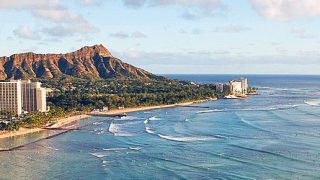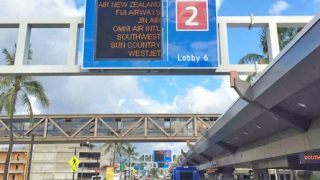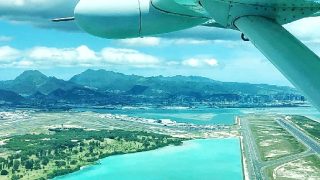Both of the recent Hawaii near-crashes have brought scrutiny of pilots, as well as the FAA here in Hawaii. See why below.
We reported late yesterday an incident that was just revealed by the FAA: Terrifying UAL Near-Miss at Honolulu Risked Catastrophy Per FAA.
Did Pilots or FAA cause the United Airlines 777 Honolulu runway incident?
In that latest incident, a UAL Boeing 777 widebody jet at Honolulu Airport crossed the runway where a smaller Kamaka Air cargo plane was landing. NTSB indicated the incident presented a “significant risk of a catastrophic outcome.”
Beat of Hawaii spoke with a very experienced Honolulu-based widebody airline pilot friend last night. He said the HNL near-crash between the Boeing widebody passenger plane and the Grand Caravan cargo plane comes down to one of two causes.
- If the pilot had been cleared to cross the runway, it was “totally on the FAA.” He indicated that FAA could have been short-staffed generally or at that time and that “Honolulu has a relatively junior FAA base.”
- Had the pilot not received permission to cross and was instructed to “hold short” of the runway, then it would have been totally the pilot’s responsibility.
Pilot Rich said, “Either the Tower gave clearance to cross the Live Runway or they did not. If they did, then we have to ask what caused that, if they did not we have to ask why the UAL flight entered a live runway without clearance. Then we have to see if the landing aircraft had been final clearance to land on that runway or not. I am wondering if it is related to confusion over runway closures and changes.”
Regular commenter John said, “Don’t think there is anything other than this is a simple human mistake and perhaps it would be a little premature to read into anything else.”
Both Rich and the other pilot both mentioned possible confusion about the Honolulu Airport complete or partial runway closure, which is still ongoing.
The airline pilot told us that the Kamaka Air Grand Caravan, while a frequent part of air traffic in Honolulu, is still a tiny plane compared to the United Boeing 777 airliner. He said that the pilot would have tried to confirm no conflicting air traffic visually. But, for various reasons, and depending on the takeoff or landing circumstances of the United plane, which hasn’t thus far been revealed, the Kamaka airplane might simply not have been seen.
This wasn’t the only recent such Hawaii incident, unfortunately.
United Airlines Flight 1722: possible causes.
There are many questions about what went wrong, which caused the United Airlines flight department Maui to drop precipitously during strong gusts and possible wind shear. But should the weather take any or all of the blame?
Some reports have mentioned that pilots may have forgotten to program the plane’s autopilot correctly. There’s also been discussion of a possible fault with the autopilot system or something else, which at this point has been said to be extremely unlikely. Also, the pilots on that flight are reported to have 25k combined flying time.
When we asked the widebody pilot about this incident, the first thing he mentioned was “were the flaps retracted?” He further indicated that wind shear would not have been the cause of the precipitous drop. So were the Boeing 777 flap settings correct for that point in the climb-out? Flap settings are critical to the ability to generate lift. We’ll leave it to other pilots here to comment since this is outside our wheelhouse.
United has already said that the crew has received additional training due to the problem. Also, the crew filed safety reports but did not notify the NTSB at the time. We will watch to see if a NASA report was filed.
Others have commented that the fact that the plane didn’t return to Maui or Honolulu and proceeded trans-Pacific some 2,500 miles is of concern, even if returning to Hawaii wasn’t technically required. If the issue was a pilot-induced error, however, there may have been no reason to look any further. So despite the extraordinary circumstances during the initial moments of the flight, they may have chosen to continue. Enters “NASA report.”
Did pilots in either case file NASA ASRS reports?
We’d never heard of this until we had the conversation yesterday with our airline pilot friend, who explained how this system works. We then researched it further.
The FAA employs NASA, since it is independent and without regulatory/enforcement capability, to be a third party in an aviation incident reporting program that began in 1976. To date, there have been more than 1.5 million incident reports filed.
According to NASA, its ASRS (Aviation Safety Reporting System) “receives, processes and analyzes voluntarily submitted incident reports from pilots, air traffic controllers, dispatchers, cabin crew, maintenance technicians, and others. Reports submitted to ASRS may describe both unsafe occurrences and hazardous situations.”
Pilots or others reporting are provided immunity against actions, including penalties or certificate actions for a safety or regulation violation incident, once every five years. The goal is to improve aviation safety.
The recent dates of these incidents mean they are not yet accessible in the reporting system. Anyone can search the NASA ASRS database for aviation incidents.
Airline pilots and FAA under pressure.
There aren’t enough airline pilots, to begin with. And with so many approaching the mandatory retirement age of 65, the problem is getting worse. By one analysis, some 10k pilots have left the industry since Covid. There is a need to fill up to 18k airline pilot positions annually, yet FAA has been issuing just half that number of pilot licenses. Southwest Airlines, for example, is reported to be parking up to 45 planes a day due to the lack of pilots to operate them.
Pilot and regular commenter Richard said about FAA air traffic controllers: “I’m finding that air traffic controllers are feeling stressed by increased air traffic; you can hear it in their voices. So I’m not surprised by the increase in air incidents and surprised that we aren’t seeing more of them. Also it would be interesting to know how many senior air traffic controllers retired during the pandemic.”
We’d love to hear from others involved in Hawaii aviation.







The airline industry has seen an explosion in post covid travel and as result a lot of new pilots in the right seat. Also a lot of very experienced pilots transitioning to new,(to them) types of equipment and new routes they were not previously senior enough to hold. Pilots new to a destination or aircraft type do make mistakes more than those with more experience. These types of mistakes are nothing new to the industry, not sure if it’s more frequent or more frequently reported. Very complex issue and the finger pointing at this generation of pilots is not the answer.
Your “widebody pilot” is wrong. It absolutely could have been windshear that caused it. We won’t know until we see the actual report.
I apparently got ahead of this question, whether the Pilots are to blame, when yesterday I commented my Extreme Doubts that they are, however, that they always are given the blame by the FAA and NTSB. I shall say it again, this Is Not Pilot Error! Look Elsewhere.
They sent them back to Pilot school, I would say it’s their fault and you’re covering for them
Out of 80+ controllers who work there, only 10 have less than 5 years experience, with over 50 of them having more than 10 years experience, and over 20 having 15+ years experience. So that was a false statement that it is a relatively junior FAA base. It is actually highly sought after and difficult to get into.
The short staffing part, however, is 100% accurate in general for the FAA, most facilities are severely understaffed because of limited hiring and antiquated hiring practices. The top Overtime earners are in the 800+ hours per year territory, think about that for a second. In a general working year there are about 2048 regular work hours. Source : FAA Air Traffic Controller
Thanks for the steady stream of Hawaiian articles!
I’m a captain on a large aircraft and frequently operate out of Honolulu. There is an error in the way it was described that “..if the control tower told the airliner landing on 4R to hold short” then it would be the pilot’s fault.
Proper FAA procedures Requires pilots to get permission Before crossing any active runway. The tower would not have had to say anything to the arriving flight. They would have had to have the situational awareness to not cross an active runway without permission. That said, it is a very short taxi from 4R to cross 4L on that taxiway. For that reason, I never save time by trying to make that taxiway and always elect to roll to the end of 4R. High workload and loss of situational awareness is likely the cause.
“High workload”? Other than the usual and customary preflight preparation and taxiing workload, what additional work could there have been in that cockpit?
Air traffic controllers, pilots and cabin crew are all highly skilled individuals who work in a high-risk industry. If we want them to be well-trained, experienced and dedicated they should be paid well. But the public demands cut-rate air fares, lots of free snacks and booze, the “right” to drag their mini suitcases on board for free and cram them into the overhead compartments, and big wide seats to accommodate their entitled derrieres. Cheap flights or safe flights? Pick one because we can’t have both.
I’m a retired USN and commercial airline pilot with over 28K hours of flight time as well as many years instructing on Boeing jets. My last base (for >10 years) was HNL flying the Pacific/CONUS as Captain on the B-747.
I saw a disappointing trend over my last 10-15 years in hiring lesser qualified pilot applicants than would have been accepted when I was first hired. Not much has happened in the interim to improve the situation — in fact it’s gotten worse. Same goes for FAA personnel.
Why?? A simple answer is money and a lack of qualified applicants. It’s always about the money when it comes to commercial aviation and while many new-hire pilots/FAA folks used to be former military that’s not so today and the results are noticeable.
Thanks, Beat, you are doing a fabulous job keeping us informed. As a very frequent HNL flyer, I’d rather be in the know about these things.
A late friend of mine was a very experienced United 747 captain out of SFO, another place that gets these thunderstorms and weather systems featuring high winds. He describes the psychological stress he endured during a such a storm siutation when he decided that winds were too high to risk taking off. He kept his Narita bound widebody on the ground, while other colleauges were continuing to take off and land. As a captain, he said, “I felt it was my responsibility to err on the side of caution, but it was agonizing to see the other planes taking off right next to us.”
Hi Alex.
Thanks! We’re appreciate the input on this and dozens of other articles.
Aloha.
I got my flight training at the Hawaii Country Club of the Air 1978. I flew out of KOA flight school, but made many flights into HNL as a student, and then licensed pilot. HNL is complicated airspace with a mix of light planes, heavies, including foreign aircrews, and military. Over years gates, parking areas, tiedowns, and maintenance facilities have relocated, and taxiways repurposed.
Over decades I have witnessed greater reliance on automated systems, particularly among civil carriers. The old guys I learned with, many WWII and Korea vets, have flown west, and a new population of commercial pilots have taken their seats. Those old guys Liked flying, and kept hands on the stick and eyes out the windows.
Well this is what happens when you force people to retire that have years of experience without a plan. Now you hire just about anyone. I live near the United training academy and they only fly when it’s sunny and no wind and fly in a big circle I watch them on flightaware. I guess these will be the replacements. Good luck with that let me know how that works out. Next thing you know we’ll be hiring oil contractors as programmers. It’s easy 🙂
Liam, a terrible thought but here it goes anyway. Those Southern States mainlanders that taught the 9/11 terrorists might still be around, get them to teach new students. It was amazing, in the wrong way, how they were able to fly around in heavy air traffic and not collide in mid air. Someone taught them well. Too bad! No disrespect to those who died.